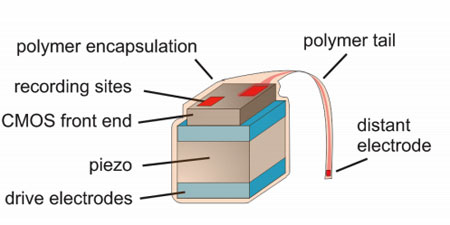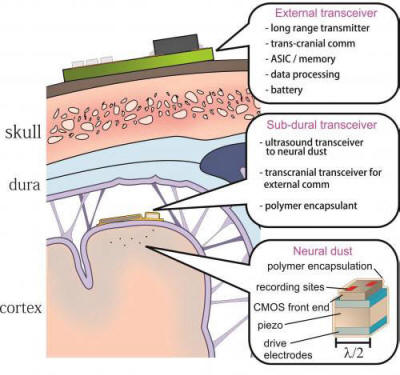Intelligent Neural Dust
Embedded in The Brain Could Be...
The
Ultimate Brain-Computer Interface
by Neurogadget
July 18,
2013
from
Neurogadget Website
A recent theoretical paper (Literal Smart Dust Opens Brain-Computer Pathway to "Spy on Your Brain") has described a system concept termed ‘neural dust’- a miniaturized low power system to support brain-computer interfaces (BCI) and monitor the brain from inside.
Embedded in the brain, the intelligent dust particles could form an entirely new form of BCI, say Berkeley Engineering researchers.
A major hurdle in brain-computer interfaces is the lack of an implantable neural interface system that remains viable for a lifetime. This paper explores the fundamental system design trade-offs and ultimate size, power, and bandwidth scaling limits of neural recording systems.
A network of tiny implantable sensors could function like an MRI inside the brain, recording data on nearby neurons and transmitting it back out. The smart dust particles would all contain an extremely small CMOS sensor capable of measuring electrical activity in nearby neurons.
The researchers envision a piezoelectric material backing the CMOS capable of generating electrical signals from ultrasound waves. The process would also work in reverse, allowing the dust to beam data back via high-frequency sound waves. The neural dust would also be coated with polymer.
Probably the biggest challenge is implanting the neural dust particles in the cortex. Dongjun Seo and colleagues say this can probably be done by fabricating the dust particles on the tips of a fine wire array, held in place by surface tension.
This array would be dipped into the cortex where the dust particles become embedded.

The long-lasting neural dust would clearly solve the problems of size and invasiveness posed by current brain imaging technologies, but don’t get your hopes up yet.
Although the ultimate BCI won’t become a reality for a while, maybe this kind of implantable data collection will be possible soon.
Literal Smart Dust Opens Brain-Computer Pathway to...
"Spy on Your Brain"
by Nicholas West
July 19, 2013
from
ActivistPost
Website
Nano-Drones
Neuroscientists Now Invading Our Brains
Some might have heard about 'Smart Dust', nanoparticles that can be employed as sensor
networks for a range of security and environmental
applications.
Now, however, literal Smart Dust for
the brain is being proposed as the next step toward
establishing a brain-computer interface.
The system is officially called "neural dust" and
works to "monitor the brain from the inside."
Inventors are attempting to overcome the hurdle of
how to best implant sensors that can remain over the
course of one's life.
Researchers at Berkeley Engineering believe they have found a novel way to achieve this:
This paper explores the fundamental system design trade-offs and ultimate size, power, and bandwidth scaling limits of neural recording systems.
A network of tiny implantable sensors could function like an MRI inside the brain, recording data on nearby neurons and transmitting it back out. The smart dust particles would all contain an extremely small CMOS sensor capable of measuring electrical activity in nearby neurons.
The researchers envision a piezoelectric material backing the CMOS capable of generating electrical signals from ultrasound waves. The process would also work in reverse, allowing the dust to beam data back via high-frequency sound waves.
The neural dust would also be coated with polymer.
(Source)
The investment in
neuroscience has received a $100 million dollar
commitment via
Obama's BRAIN project, while Europe has
committed
$1.3 billion to build a supercomputer replica of the
brain in a similarly comprehensive and detailed
fashion as the Human Genome Project mapped DNA.
Concurrently, there is massive long-term investment in nanotech applications via the National Nanotechnology Initiative 2011 - Strategic Plan.
This 60-page document
lays out a projected future "to understand and
control matter" for the management of every facet of
human life within the surveillance matrix of
environment, health and safety. Twenty-five U.S.
Federal agencies are participating.
The concept of Smart Dust has been applied and/or
proposed for use in the following ways, just to name
a few:
Nano sensors for use in agriculture that measure crops and environmental conditions.
Bomb-sniffing plants using rewired DNA to detect explosives and biological agents.
"Smart Dust" motes that wirelessly transmit data on temperature, light, and movement (this can also be used in currency to track cash).
However, this is the first time that there is a working plan to apply Smart Dust to the human brain.
Researchers claim it will be some time before (if ever) this is workable. One aspect that is interesting to note, is that once these particles are sent into the brain, it will be ultrasound that activates the system for full monitoring.
This is an area of research that also has been looked at by DARPA as one of the future methods of mind control.
Their idea is to sprinkle electronic sensors the size of dust particles into the cortex and to interrogate them remotely using ultrasound. The ultrasound also powers this so-called neural dust.
Each particle of neural dust consists of standard CMOS circuits and sensors that measure the electrical activity in neurons nearby...
The neural dust is interrogated by another component placed beneath the scale but powered from outside the body. This generates the ultrasound that powers the neural dust and sensors that listen out for their response, rather like an RFID system.
The system is also tetherless–the data is collected and stored outside the body for later analysis.
Read "tetherless" as "wireless" - or remote controlled analysis of the human brain, thus opening the door (theoretically) for remote mind control.
As I've highlighted before, this is a two-way street - some people might feel content, for example, with sending their brain's information out to a doctor for evaluation, but this sensor network could also transmit data back, as is admitted here:
That’s why Seo and co have chosen ultrasound to send and receive data.
They calculate that the power required to use electromagnetic waves on the scale would generate a damaging amount of heat because of the amount of energy the body absorbs and the troubling signal-to-noise ratios at this scale.
By contrast, ultrasound is a much more efficient and should allow the transmission of at least 10 million times more power than electromagnetic waves at the same scale.
In case anyone
believes that this has little chance of success, MIT
highlights that one of the authors of the research
has already achieved this with a remote controlled
beetle.
The human brain is clearly of vast, perhaps
infinite, complexity - and this is without even
introducing concepts such as "the mind" or "the
soul."
Nevertheless, it is clear that the reductionists are doing their very best to "Solve the Brain" - measuring it, mapping it, and making sense of it.
(source)
Are we to believe
that "controlling it" has been left off the list for
mere ethical reasons? Not likely.
Full paper

